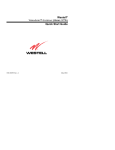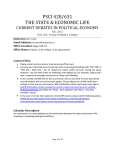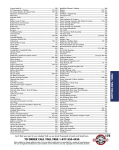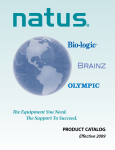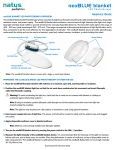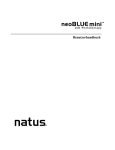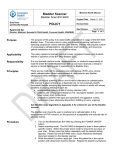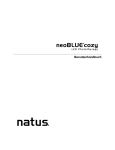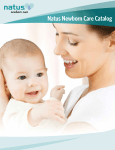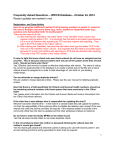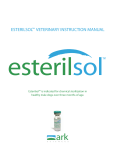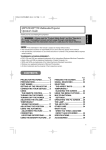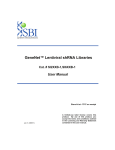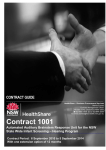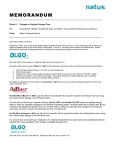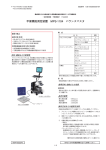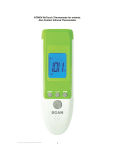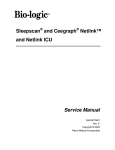Download NeoBLUE Blanket Use of Guidelines
Transcript
Misericordia Community Hospital NeoBLUE Blanket Use of Guidelines Women’s Health Equipment Date Approved Date Effective March 2012 Approved by: Next Review Director, Women’s Health, Covenant Health, GNH/MCH March 2015 Page 1 of 3 Purpose To maximize desired effects of phototherapy while minimizing the complications from that administration. Policy Statement To ensure correct use of NeoBLUE by all Covenant Health Users. Applicability All Covenant Health Staff on Postpartum Unit, Misericordia. Responsibility Procedure The neoBLUE blanket LED Phototherapy System is positioned underneath the baby to deliver phototherapy via a blue LED light source & fiberoptic blanket Most Effective Degradation of Bilirubin The neoBLUE blanket LED Phototherapy System meets AAP Guidelines for intensive, efficacious phototherapy2 Intensity Delivers intensive phototherapy: > 30 µW/cm2/nm Spectrum Utilizes blue light emitting diode (LED) technology. The LED emits blue light in the 450 – 475 nm spectrum — matching the peak absorption wavelength (458 nm) at which bilirubin is broken down. Surface Area Coverage Delivers phototherapy over a larger effective treatment area than other fiberoptic devices. Safety Features The neoBLUE LED does not emit light in the ultraviolet (UV) range — reducing the potential risk of skin damage. The neoBLUE LED does not emit light in the infrared radiation (IR) range — reducing the potential risk of fluid loss. Device automatically shuts off in the event of light box overheating. Flashing indicator light alerts user to check for blocked air vents. NeoBLUE – Use of - Guidelines Date Approved Page 2 of 3 Designed For Comfort & Support Streamlined, oval design conforms to the shape of the baby. Large and small blanket sizes available. Mattress provides comfortable cushioning underneath the infant. Disposable mattress covers ensure clean, soft surface for baby. A blanket can be used in conjunction with the neoBLUE blanket for added warmth & comfort. Baby can be held or nursed without interrupting phototherapy, encouraging infant-parent bonding. Nursing Procedure: 1. Check the order for phototherapy. 2. Education of the mother on how the equipment works and why it is necessary. 3. Place the neoBLUE blanket with mattress in the bassinet. 4. Position the blanket light box so the air vents have unobstructed air movement and insert into the fiberoptic coupling. 5. Insert power supply into the rear of the light box. The power cord should be plugged into the outlet minimizing the possibility of falls. 6. Apply disposable mattress covers to blanket mattress. 7. Turn ON the neoBLUE using the on switch when the baby is ready. Check the light intensity weekly (this is done by Lanston Kallusky, Biomed starting on the 26th March 2012. Should be greater than 30uW/cm2/nm. Care of the Infant: 1. Newborn may remain in mothers room. 2. Apply eye lubricant to the eyes prior to going under the phototherapy lights and then a minimum every 8 hrs or more frequently if needed. Routine eye care consists of removing the eye patches and checking for signs of conjunctivitis or irritation and reapplying lubricant as well as routine eye care. Newborn Label to be placed on the eye lubricant. Can be kept at the bedside for repeat use. Eye patches: Ensure that the eyelids are shut and cover with opaque phototherapy eye patches. Secure the eye patches ensuring patches do not put pressure on the eyelids. This is to prevent the cornea of the eyes from drying. Covering the eyes prevents retinal damage from the light. The nurse or mother may remove the pads when the baby is not exposed to the lights such as when breast feeding. Only the nurse may reapply the patches to ensure that it is correctly applied. NeoBLUE – Use of - Guidelines Date Approved Page 3 of 3 3. The infants temperature should be taken before the phototherapy begins. Monitor temperature hourly x 4hrs then monitor every 4 hours.. This will be the screen for temperature instability especially as one of the effects of phototherapy on bilirubin is the production of heat. All other vitals signs must be taken prior to starting the phototherapy and then every 4 hours. 4. Monitor for signs of dehydration by observing the skin turgor and mucus membranes and monitoring the in and output weigh the diapers for an accurate measurement if ordered. 5. Follow the orders for supplementation of fluids where necessary. Assess the stool characteristics and record and change the diapers frequently and examine the perianal areas. Loose stools are often irritating. If diarrhea occurs and the baby appears dehydrated, inform the physician. Documentation: Document when the device was initiated and the serum bilirubin level. Document the vitals signs on the newborn caremap. Document on the Medication Record the eye lubricant and on the Newborn Record who applied the eye patches each time they are placed. Document the frequency of feeding and amount if bottle feeding. Document supplements. Record the in and output Remark on the eyes, skin and buttocks every 4 hrs. Document how the family is coping. References Brown,Y.,Evans,M.,Evans,R.,Orshan,S. (2010). Canadian Maternity Newborn and Women’s Health. The High Risk Infant( 2nd Ed.,pp923-926) Lippincott Williams & Wilkins. Adopted with permission from the Stollery Childrens Hospital: http://www.intranet.cha.ab.ca/nicu/Documents/PoliciesProcedures/Integument/phototherapy_pro.p on the 23rd March 2012 Natus Medical neoBLUE blanket User manual Retrieved from http://www.natus.com/index.cfm?page=products_1&crid=583 on the 22nd March 2012



